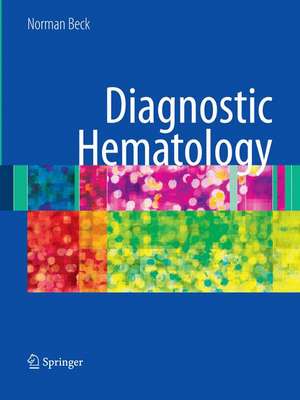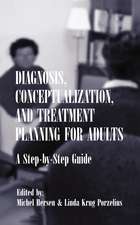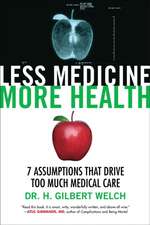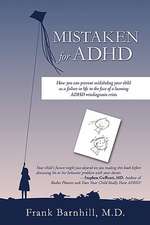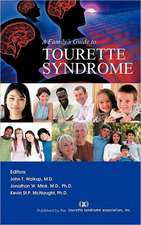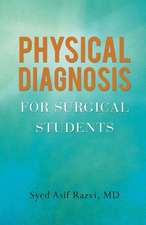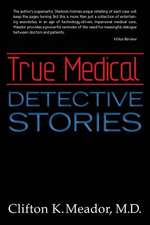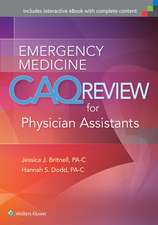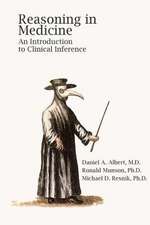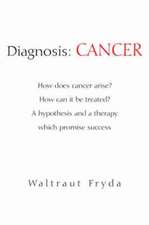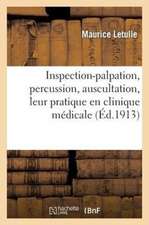Diagnostic Hematology
Autor Norman Becken Limba Engleză Paperback – 16 ian 2009
Preț: 1195.18 lei
Preț vechi: 1258.09 lei
-5% Nou
Puncte Express: 1793
Preț estimativ în valută:
228.73€ • 237.91$ • 188.83£
228.73€ • 237.91$ • 188.83£
Carte tipărită la comandă
Livrare economică 15-29 aprilie
Preluare comenzi: 021 569.72.76
Specificații
ISBN-13: 9781848002821
ISBN-10: 1848002823
Pagini: 488
Ilustrații: XXX, 488 p. 90 illus. in color.
Dimensiuni: 210 x 280 x 280 mm
Greutate: 1.36 kg
Ediția:2009
Editura: SPRINGER LONDON
Colecția Springer
Locul publicării:London, United Kingdom
ISBN-10: 1848002823
Pagini: 488
Ilustrații: XXX, 488 p. 90 illus. in color.
Dimensiuni: 210 x 280 x 280 mm
Greutate: 1.36 kg
Ediția:2009
Editura: SPRINGER LONDON
Colecția Springer
Locul publicării:London, United Kingdom
Public țintă
Professional/practitionerDescriere
Hematology is difficult to teach at the medical school level. The curriculum is necessarily fragmented across different years of study, and often separated considerably in time. Understanding hematology requires insight into several distinct aspects: applied physiology (generally taught early), an understanding of the essential pathological processes involving the blood are taught somewhat later (if at all), and the (necessarily) strong laboratory aspect is generally taught more or less concurrently with other clinical pathology topics, such as clinical chemistry and immunology. By the time the student is faced with blood diseases in the wards, the laboratory/pathological bias is well entrenched. It is thus difficult for the student to get an integrated view of the subject. The unspoken assumption, often reinforced by clinical tutors trained in the traditional perspective, is that blood tests are all that are required for a diagnosis in blood diseases.
The result has been that clinical expertise in blood diseases is generally poor. This is reflected in the importance given to the examination of the hematological system in most student primers. The hematological system, by and large, is almost completely neglected. Such relevant features such as pallor, jaundice, bleeding, splenomegaly and so on are dealt with either in passing or in relation first to another system or the ‘general examination’. It is almost as though it is taken for granted that the haematological system cannot be assessed clinically – and yet, as demonstrated later in the book, it is in very many cases impossible to reach a complete haematological diagnosis without clinical assessment.
Effective, patient-centred care of hematological patients requires, as with all other patients, a comprehensive clinical insight into these disease processes, i.e. an integrated clinical and pathological approach. Added to these problems is the fact that the number of laboratory tests has increased explosively, and the laboratory simply does not have the time to attempt more than a brief, generalized, and increasingly, an automated interpretation of the results. Thus the onus of clinical interpretation necessarily falls more and more on the attending clinician, whose grounding in clinical haematology is too often inadequate, for the reasons mentioned.
Hematology is emerging as a clinical specialty in its own right. The training of hematology physicians today includes extensive clinical exposure (indeed they are expected to handle the clinical aspects themselves), while training of medical registrars requires considerable knowledge of haematology and its reports. Achieving an integrated approach would be made immeasurably easier by a book presenting the subject in a fully integrated, clinical way. This then has been the motivation for this book.
There is no shortage of hematological texts, some of them very good, and it would be presumptuous and self-indulgent to add to them without clear justification. However, practically all of the student-orientated texts tend still to teach hematology from a formal and largely static laboratory perspective, and the reports emanating from the laboratory tend to reinforce this. Many of the ‘Crash Course’ types of hematology book on the market have (at least) two major weaknesses: they considerably oversimplify the subject, contributing to the very mechanistic and almost anti-intellectual approach to blood diseases and especially to the FBC and Hemostatic Screen; and they tend to concentrate on primary blood diseases, whereas in practice most abnormalities of the blood and in the FBC are secondary to disease outside the system – that is to say, they work primarily from a pathological and not from a clinical viewpoint. The FBC is one of the most common and valuable tests in use; it is a relatively expensive test and generally speaking is poorly interpreted, and the potential wealth of information that can be gleaned is missed.
The approach described in this book is different from that in most student texts, and has been very successful in practice, starting almost from scratch, but omitting many of the ‘basics’ such as the details of hematopoiesis, laboratory technology, and so on, which are hardly relevant to the practising clinician and student in the wards, and are primarily of interest to the hematologist and sometimes to the clinical specialist. Considerable emphasis is given to the clinical history and examination, and the interpretation of the clinical patterns thus exposed. Hopefully it will overcome many of the traditional problems experienced in practical diagnostic haematology.
All the practical essentials are covered, and effectively this book contains all the information the student will ever need, apart from details of therapy (until and unless they enter certain specialties).
The book is restricted to adult haematology, for practical reasons. While there are considerable areas of similarity between adult and paediatric haematology, there are also very significant differences. Thus, the only congenital diseases discussed in this book are those that can present after childhood and occasionally those that pose a significant problem in adult practice. Generally these are discussed only briefly. Often with these the assistance of a haematologist would have to be sought anyway. Sometimes even the haematologist may have to further consult someone sub-specializing in paediatric haematology.
The result has been that clinical expertise in blood diseases is generally poor. This is reflected in the importance given to the examination of the hematological system in most student primers. The hematological system, by and large, is almost completely neglected. Such relevant features such as pallor, jaundice, bleeding, splenomegaly and so on are dealt with either in passing or in relation first to another system or the ‘general examination’. It is almost as though it is taken for granted that the haematological system cannot be assessed clinically – and yet, as demonstrated later in the book, it is in very many cases impossible to reach a complete haematological diagnosis without clinical assessment.
Effective, patient-centred care of hematological patients requires, as with all other patients, a comprehensive clinical insight into these disease processes, i.e. an integrated clinical and pathological approach. Added to these problems is the fact that the number of laboratory tests has increased explosively, and the laboratory simply does not have the time to attempt more than a brief, generalized, and increasingly, an automated interpretation of the results. Thus the onus of clinical interpretation necessarily falls more and more on the attending clinician, whose grounding in clinical haematology is too often inadequate, for the reasons mentioned.
Hematology is emerging as a clinical specialty in its own right. The training of hematology physicians today includes extensive clinical exposure (indeed they are expected to handle the clinical aspects themselves), while training of medical registrars requires considerable knowledge of haematology and its reports. Achieving an integrated approach would be made immeasurably easier by a book presenting the subject in a fully integrated, clinical way. This then has been the motivation for this book.
There is no shortage of hematological texts, some of them very good, and it would be presumptuous and self-indulgent to add to them without clear justification. However, practically all of the student-orientated texts tend still to teach hematology from a formal and largely static laboratory perspective, and the reports emanating from the laboratory tend to reinforce this. Many of the ‘Crash Course’ types of hematology book on the market have (at least) two major weaknesses: they considerably oversimplify the subject, contributing to the very mechanistic and almost anti-intellectual approach to blood diseases and especially to the FBC and Hemostatic Screen; and they tend to concentrate on primary blood diseases, whereas in practice most abnormalities of the blood and in the FBC are secondary to disease outside the system – that is to say, they work primarily from a pathological and not from a clinical viewpoint. The FBC is one of the most common and valuable tests in use; it is a relatively expensive test and generally speaking is poorly interpreted, and the potential wealth of information that can be gleaned is missed.
The approach described in this book is different from that in most student texts, and has been very successful in practice, starting almost from scratch, but omitting many of the ‘basics’ such as the details of hematopoiesis, laboratory technology, and so on, which are hardly relevant to the practising clinician and student in the wards, and are primarily of interest to the hematologist and sometimes to the clinical specialist. Considerable emphasis is given to the clinical history and examination, and the interpretation of the clinical patterns thus exposed. Hopefully it will overcome many of the traditional problems experienced in practical diagnostic haematology.
All the practical essentials are covered, and effectively this book contains all the information the student will ever need, apart from details of therapy (until and unless they enter certain specialties).
The book is restricted to adult haematology, for practical reasons. While there are considerable areas of similarity between adult and paediatric haematology, there are also very significant differences. Thus, the only congenital diseases discussed in this book are those that can present after childhood and occasionally those that pose a significant problem in adult practice. Generally these are discussed only briefly. Often with these the assistance of a haematologist would have to be sought anyway. Sometimes even the haematologist may have to further consult someone sub-specializing in paediatric haematology.
Cuprins
Preface, Introduction. Before you start., Blood Diseases and their Diagnosis I, Blood Diseases and their Diagnosis II, Clinical Interactions between the Blood and other Systems, The Principles of Diagnosis and the Clinical Examination, A Practical Approach to the FBC and Haemostatic Screen., The Bone Marrow Report., Anaemia: General Considerations., Microcytosis: The Microcytic Anaemias., Macrocytosis: The Macrocytic Anaemias., Normocytosis: The Normocytic Anaemias, Thrombocytopenia., Thrombocytosis., The Leukocytoses. , The Leukopenias., Pancytopenia and Bicytopenias., Polycythaemia., Erythrocytosis., Bleeding Tendencies., Transfusion-Related Problems., Iron Overload., The Hypercoagulable States., Immune Deficiencies and the Immunoproliferative Disorders., Mixed, Complex and Compound Disorders., Bibliography and Suggested Reading., Appendices.
Recenzii
From the reviews:
"Practical diagnoses of adult hematological disorders from a clinical perspective are the focus of this book. … Written for the ‘practicing clinician and student in the wards,’ this book would be helpful to generalists … medical students, and pathology residents early in their training. It might also be useful for practicing pathologists as a refresher on the clinical aspects of diseases frequently subject to esoteric laboratory testing. … This is a great book containing a wealth of pearls on clinical diagnoses of adult hematological disorders." (Valerie L. Ng, Doody’s Review Service, February, 2009)
"Practical diagnoses of adult hematological disorders from a clinical perspective are the focus of this book. … Written for the ‘practicing clinician and student in the wards,’ this book would be helpful to generalists … medical students, and pathology residents early in their training. It might also be useful for practicing pathologists as a refresher on the clinical aspects of diseases frequently subject to esoteric laboratory testing. … This is a great book containing a wealth of pearls on clinical diagnoses of adult hematological disorders." (Valerie L. Ng, Doody’s Review Service, February, 2009)
Textul de pe ultima copertă
Hematology is sometimes regarded as a purely laboratory subject, but is a clinical specialty in its own right. Understanding hematology requires insight into several distinct aspects: applied physiology, understanding the essential pathological processes of the blood, and the laboratory aspects. Nevertheless, there is no substitute for the clinical approach in the final assessment and management of any patient’s disease, of whatever nature, and therefore, independent of any diagnostic test, the final evaluation and judgment must come from the clinician.Diagnostic Hematology approaches the topic from the clinical decision-making perspective. It stresses the importance of effective, patient-centered care of hematological patients, requiring a comprehensive clinical insight into the disease processes, and thus provides an integrated clinical and pathological approach. Considerable emphasis is placed on obtaining the clinical history and examination, and the interpretation of the clinical patterns that are exposed from the ever increasing number of laboratory tests available. All the practical essentials are covered, ensuring that this book contains the vital clinical information needed by all physicians involved in hematological diagnoses.
Caracteristici
Practical guide to clinical assessment of the hematological system
Considerable emphasis given to the clinical history and examination, and interpretation of clinical patterns exposed
Considerable emphasis given to the clinical history and examination, and interpretation of clinical patterns exposed
